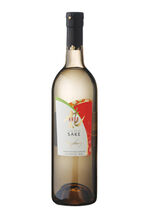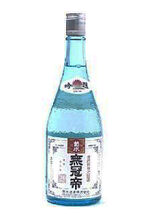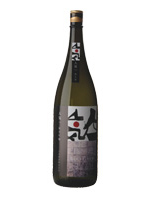Tokutei meishoshu 特定名称酒 (also Tokutei meisho-shu) is what's known as "special designation" sake, Tokutei meisho meaning "special designation," and the "shu" suffix meaning "sake." The sake in this group are primarily distinguished from each other by the percentage of milling or "polishing" done to the rice grains themselves, as well as the presence or absence of brewer's alcohol added during production. If no alcohol has been added to the sake it will bear the Junmai 純米 (pure rice) prefix, and if alcohol has been added it will lack this prefix. Listed here are some of the varieties of sake in this designation.
Junmai / Honjozo[]

Junmai-shu
Sake in this grade is made with rice that has been polished down at least 30%, so that a maximum of 70% of the original grain remains. this is the lowest grade of special designation sake.
- Junmai 純米 often has a fuller, richer body and a higher-than-average acidity. As stated above, Junmai means "pure rice," so no alcohol is added in it's production.
- Honjozo 本醸造 is brewed with a small amount of distilled pure alcohol added to achieve a smoother and lighter flavor profile, and to make the sake a bit more fragrant. Honjozo often makes a good candidate for warm sake.
Junmai Ginjo / Ginjo[]

Ginjo-shu
This grade of sake uses rice with a level of milling no less than 40%, leaving a maximum of 60% of the grain for the brewing process. This is the middle grade of the special designation sake, but sake of this variety are considered premium.
- Junmai Ginjo 純米吟醸 sake is more delicate, light and complex than the more ordinary Honjozo or Junmai. this is due to the fact that the rice has had at least 10% more of the outer layer of the grains polished away, leaving only the inner 60% or less. This means that less of the fats and protein which are considered impurities are used, and the rice is closer to being pure starch. In addition to this, special yeast, lower fermentation temperatures, and hands-on labor-intensive techniques are employed making for more fragrant, complex brews.
- Ginjo 吟醸 is similar in nearly every way to Junmai Ginjo. However, as the name suggests, brewer's alcohol is added to further enrich the flavor and bouquet of this variety.
Junmai Daiginjo / Daiginjo[]

Junmai Daiginjo-shu
This is the highest grade of sake, and as you can imagine, the most expensive. Sake at this level not only uses rice that has been milled down to 50% of it's original size or less, but a much more painstaking and hands-on approach is taken to ensure maximum quality throughout every stage of production. Great care is taken to ensure that these sake are the pinnacle of the craft they represent, and some sake of this class use rice that has been milled down to a mere 35% of it's original size, or even less.
- Sake bearing the Junmai Daiginjo 純米大吟醸 designation are ultra-premium brews, and represent the best of the best in the world of premium pure-rice sake. These sake are the epitome of excellence in the craft of sake brewing, and are highly sought-after by connoisseurs.
- Daiginjo 大吟醸 sake are as close to perfection as their pure-rice Junmai counterparts, however distilled brewer's alcohol is added during the brewing process in order to fine-tune their flavor profile. Some purists frown on this variety, feeling that the addition of alcohol to such an otherwise perfect brew is unnecessary, and detracts from the hard work and dedication involved in such a high level of quality brewing.